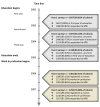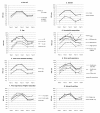Change in depressive symptoms over higher education and professional establishment - a longitudinal investigation in a national cohort of Swedish nursing students
- PMID: 20550704
- PMCID: PMC2905329
- DOI: 10.1186/1471-2458-10-343
Change in depressive symptoms over higher education and professional establishment - a longitudinal investigation in a national cohort of Swedish nursing students
Abstract
Background: There are indications of a high prevalence of psychological distress among students in higher education and also that distress increases over the course of study. However, not all studies on student distress controlled for sociodemographic differences and few followed development of distress over an extended period through professional establishment. We investigated if there is an independent effect of time in education and the first two years in the profession on depressive symptoms and mapped change over the period in a national cohort of students.
Methods: Data came from LANE, a nation-wide longitudinal panel survey of Swedish nursing students (N = 1700) who responded to annual questionnaires over five years from 2002 to 2007. Depressive symptoms were measured by the Major Depression Inventory and change over time analysed in a linear mixed effects model for repeated measures.
Results: There was a significant change in level of depressive symptoms over time: an increase from the first to later years in education and a decrease to levels similar to baseline after graduation and a year in the profession. The change in symptoms remained significant after adjustment for sociodemographic factors (p < 0.01). Symptom levels differed due to age, gender, household composition and prior nurse assistant training but change over time was similar in all groups. The correlation among the repeated measures, representing within individual correlation over time, varied between 0.44-0.60.
Conclusions: The findings indicate an independent but transitional effect of time in education and professional establishment on depressive symptoms. We think heightened distress over education abates as the graduate accommodates to the profession. Nevertheless, within education, the differences in depressive symptoms associated to demographic factors can help identify student groups more vulnerable to distress. Also, as individual differences in distress seem to persist over time, perhaps students highly distressed in the beginning of education can be helped by awareness among educators of the elevated levels of distress in late education.
Figures



Similar articles
-
Self-reported depression in first-year nursing students in relation to socio-demographic and educational factors: a nationwide cross-sectional study in Sweden.Soc Psychiatry Psychiatr Epidemiol. 2011 Apr;46(4):299-310. doi: 10.1007/s00127-010-0198-y. Epub 2010 Mar 7. Soc Psychiatry Psychiatr Epidemiol. 2011. PMID: 20213328
-
Burnout during nursing education predicts lower occupational preparedness and future clinical performance: a longitudinal study.Int J Nurs Stud. 2012 Aug;49(8):988-1001. doi: 10.1016/j.ijnurstu.2012.03.010. Epub 2012 Apr 25. Int J Nurs Stud. 2012. PMID: 22542085
-
Early-career burnout among new graduate nurses: a prospective observational study of intra-individual change trajectories.Int J Nurs Stud. 2011 Mar;48(3):292-306. doi: 10.1016/j.ijnurstu.2010.07.012. Epub 2010 Aug 8. Int J Nurs Stud. 2011. PMID: 20696427
-
A longitudinal study of stress and psychological distress in nurses and nursing students.J Clin Nurs. 2009 Jan;18(2):270-8. doi: 10.1111/j.1365-2702.2008.02555.x. J Clin Nurs. 2009. PMID: 19120753
-
Nurses' development of professional self--from being a nursing student in a baccalaureate programme to an experienced nurse.J Clin Nurs. 2008 May;17(10):1380-91. doi: 10.1111/j.1365-2702.2007.02014.x. Epub 2008 Feb 11. J Clin Nurs. 2008. PMID: 18266848
Cited by
-
Analysis of an Egyptian study on the socioeconomic distribution of depressive symptoms among undergraduates.Soc Psychiatry Psychiatr Epidemiol. 2012 Jun;47(6):927-37. doi: 10.1007/s00127-011-0400-x. Epub 2011 May 31. Soc Psychiatry Psychiatr Epidemiol. 2012. PMID: 21626055
-
Association between Depression and Factors Affecting Career Choice among Jordanian Nursing Students.Front Public Health. 2017 Nov 22;5:311. doi: 10.3389/fpubh.2017.00311. eCollection 2017. Front Public Health. 2017. PMID: 29214151 Free PMC article.
-
Effects of mental health interventions for students in higher education are sustainable over time: a systematic review and meta-analysis of randomized controlled trials.PeerJ. 2018 Apr 2;6:e4598. doi: 10.7717/peerj.4598. eCollection 2018. PeerJ. 2018. PMID: 29629247 Free PMC article.
References
-
- Cotton SJ, Dollard MF, de Jonge J. Stress and student job design: Satisfaction, well-being, and performance in university students. Int J Stress Manag. 2002;9:147–162. doi: 10.1023/A:1015515714410. - DOI
MeSH terms
LinkOut - more resources
Full Text Sources

